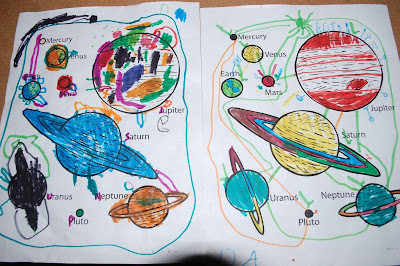I remembered a song from when I was little that I taught the boys, it says "Mercury, Venus, the Earth and Mars, these are the planets thar dwell near our stars. Jupiter, Saturn, and Uranus, too. Neptune and Pluto, I know them, do you?". So I know that Pluto is now considered a dwarf planet, but we still learned the song and it still teaches where to find it, but we did explain that as best as we could.

That first night we spent time coloring a picture of all the planets and talking about each one. this video on YouTube that is a song about the solar system (The Solar System Song by KidsTV123). The kids wanted to watch it over and over. Interesting facts about each planet are introduced.
I also found this book at the dollar store about space and we went through it learning tid bits about each planet.
These are some of the facts that we shared and we colored each planet as we were discussing:
Mercury: No moons, closest to the sun, made of rock, fastest orbit of the sun
Venus: Same size as the Earth, spins opposite was as the Earth, no moons
Earth: Only planet with life, looks blue because of the water, it's where we live, one moon
Mars: Looks red because of it's dirt (iron oxide if you want to get specific), two moons, largest volcano in the solar system in called Olympus Mons and is on Mars
Asteroid Belt: Between Jupiter & Mars
Jupiter: Biggest, spins the fastest, has 63 moons, has a Great Red Spot that is a giant storm that has been going for at least 340 years, a day is less than 10 hours on Jupiter
Saturn: 7 Large Rings made of dust & ice, Titan is its biggest moon, 2nd largest planet
Uranus: Tilted on its side, coldest planet in the solar system, a season lasts 20 years, blue from methane
Neptune: Windiest planet, 13 moons, methane makes it look blue
Pluto: a dwarf planet, along with Ceres & Eris.
I found some great resources at this website, including links to other pages and the coloring pages that I used. www.Space.com is another great site. I also got some FABULOUS, FREE apps from the app store for our IPad. The first is called Space Journey. You can get a look at the whole solar system and zoom in on each planet. Then you can speed up or slow down time and get a look at how they orbit the sun and rotate! So much fun to explore! The other one that we love is called SkyView Free. I know you can upgrade for a cost, but we love it as is! You can hold it up at the sky or down at the ground and it will show you what stars are there, and even draw out the constellations for you! You can track the moon to see what time it will be in what section of the sky, and the fun thing we discovered today was tracking the Hubble Telescope!

Our final activity was creating our own solar system from balloons! We tried to match correct color and size as best we could. Dallin even drew the Great Red Spot on Jupiter. I had the boys help me sound out each planets name as I wrote it on the balloon. We used the song to help us remember the order, and even found some stray Kix cereal on the floor (thanks to the baby earlier and my laziness in not sweeping...;)) to act as our asteroid belt! The kids loved it! After we got them all in order, we played a game where I asked a question and they ran and picked up the balloon for the planet that was the answer. For example: Which planet has 63 moons? Jupiter!

No comments:
Post a Comment